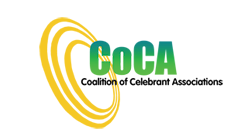Celebrancy
What comprises this sector?Celebrants can provide a range of ceremonies, celebrations, and related services for major life events, from birth to death. Ceremonies and celebrations that they provide can be categorised as related to love, life and loss
- love - betrothal or engagement, marriage, celebration of marriage, civil union, commitment, renewal of vows, wedding anniversaries
- life - christening, baby blessings, namings, coming of adolescence, coming of age, graduation, major birthdays, retirement, house warmings, coming of wisdom age, liferals, boat blessings, living wakes, community ceremonies for occasions such as citizenship affirmation, national or international days
- loss - funerals, memorials, companion animals’ funerals, divorce, community ceremonies for occasions such as military losses or natural disasters
To perform a valid marriage under Australian law1, the celebrant must be authorised as a Minister of a Recognised Religion (Subdivision A), a marriage officer with a state or territory registry of Births, Deaths and Marriages or other State officer (Subdivision B), or an individual authorised by the Commonwealth Attorney-General’s Department. The latter group are comprised of two sub-divisions C (civil celebrants) and D (religious celebrants) must complete the Certificate IV in Celebrancy, which includes three marriage celebrancy units of competency, to be authorised by Commonwealth Attorney-General’s Department.
Structure of sector (overarching demographics, regulations, etc)
The peak body Coalition of Celebrant Associations (CoCA) Inc’ National Celebrant Survey 20162 indicated that 90% of independent celebrants offer general ceremonies in addition to marriage ceremonies with 60% offering funerals, memorials and loss based ceremonies. The workforce is predominantly female (71%) with 46% over the age of 60 years, 41% between 40 and 60 years and only 13% under the age of 40 years3. Civil marriage celebrants perform over 75% of all marriages in Australia, even though they comprised only 25% (8620 in July 20164). The remaining 75% are Ministers of Recognised Religions (Subdivison A) and independent authorised religious marriage celebrants (Subdivision D.
Sub-sector Issues
As the Client Services sector is varied, each sub-sector will be looked at individually in terms of its social, political and economic impact.
Celebrancy
The most recent ABS report13 indicates:
● There were 118,401 marriages registered and 46,604 divorces granted in Australia in 2016.
● Couples who lived together prior to marriage accounted for 80.8% of all marriages registered in 2016, a decrease from the 81.0% recorded in 2015.
● The median age of couples marrying for the first time has continued to slowly rise over the past two decades, with grooms now likely to be closer to 30 years and the bride in her late twenties.
Australian men and women are getting married later but also staying married longer, with the number of divorces granted declining over the last 20 years. The marriage sector14 over the previous five years saw a decline in marriage numbers. This continues a six decade trend, since the 1960s, of decreasing crude rate of marriages (i.e the rate per head of population). The highest actual number of marriages was been between 2009 and 2012 and 2014 (ie. Over 120,000 pa).
Whilst it is estimated that the wedding industry generates over $2 billion15 annually, authorised marriage celebrants receive a tiny proportion of that income. Despite performing over 76% of all marriages, 67 % of independent civil celebrants report earning less than $10,000 pa gross from their marriage and other ceremony work, 78 % earning less than $20,000 pa and other ceremony work and only 1.4% earning close to the average Australian full time wage equivalent with an annual gross income of $75,000 and over16.
The 2016 CoCA National Celebrant Survey conducted in 201617 found that 54.5 % of independent celebrant perform less than 9 marriages, with 7 % performing no marriages at all. A further 21 % of celebrants performed 10 to 19 marriages. This means that over 75% of independent celebrants are unable to gain the on-the-job experience. The peak body CoCA considers the minimum standard for professional development. (i.e. an average of 24 marriages per celebrant per annum18 for the Subdivision C marriage celebrants).
Ensuring that graduates of the VET system have all the skills and knowledge required as a celebrant by graduation is difficult in the current context. As noted above, the role of the VET system is to ensure celebrant graduates have developed “the skills and qualifications needed to allow them to participate effectively in the labour market’, and yet almost all independent celebrants (98%) are not able to make the equivalent the average Australian full time wage19. Celebrancy training has specific limitations because graduates must be competent to deliver high quality once-in-a-life events every time and due to the competitive context in which independent celebrants work, trainees do not have access to hundreds of hours of placement or mentoring/ supervision, as is possible in other qualifications.
As Australia continues to become a more secular society, celebrants will become more sought after to perform these services rather than traditional religious ministers. IBIS World anticipates that civil marriage celebrants will gain market share due to the ongoing preference for secular marriages, rather than those performed by ministers of religion. This trend is expected to continue over the next five years20.
Challenges and Opportunities
Marriage, Divorce and Death
The impact on the Celebrants’ industry of the 2017 Same-Sex Marriage (SSM) plebiscite and its recent ratification in Parliament is assumed to be significant in that it may open up a new potential customer stream for celebrants performing civil ceremonies. Some assume a significant positive impact with reference our neighbour New Zealand’s experience, which led to a wave of international same-sex wedding tourism, when same sex marriage became legal there in 2013. The peak body, CoCA, consider there are a number of factors that mean Australian celebrants are unlikely to benefit to the same extent as their NZ colleagues. Australia already has excellent laws giving de-facto couples almost all the same rights and privileges as married couples - kinship relationships being the major exception, that is now covered with SSM. Marriage rates are expected to grow27, although it is unclear what role the SSM sector will play in providing opportunity for celebrants over the coming years.
As the population continues to increase there is an opportunity for Celebrants to perform ceremonies including marriages and funerals. The Intergenerational Report (IGR) shows that both the number and proportion of Australians aged 65–84 and 85 years and over are projected to grow substantially. In 2015, approximately 3 million people, or 13% of the population, were aged 65–84, and 500,000 people, or 2% of the population, were aged 85 years and over. By 2054–55, the 65–84 cohort is projected to be around 7 million people, or just under 18% of the population, and the 85 years and over group is projected to be around two million people, or 5% of the population28. As the population ages and increases the need for civil celebrants to perform funeral ceremonies will become more sought after. However new VET graduates coming into the industry without attention on making funeral/ memorial work and general ceremony work their major focus, the majority still seem to see marriage work as the core work, and many graduate without having done the loss / grief and related ceremony units.
While divorce still occurs, the rate at which it does in Australia has been declining. 10 years ago the divorce rate was 2.7 per 1,000 people, and one year ago it was 2.2. It is now 2.1 per 1,000 people29. There is still a need for family dispute and financial counsellors, as with divorce often comes the need for emotional and psychological assessment and support services for the couple and for any children involved.marriage work as the core work, and many graduate without having done the loss / grief and related ceremony units.
While divorce still occurs, the rate at which it does in Australia has been declining. 10 years ago the divorce rate was 2.7 per 1,000 people, and one year ago it was 2.2. It is now 2.1 per 1,000 people29. There is still a need for family dispute and financial counsellors, as with divorce often comes the need for emotional and psychological assessment and support services for the couple and for any children involved.
Read more about Industry Skills Forecasts - for Public Consultation
Download: Draft Direct Client Care and Support 2018 Industry Skills Forecast.
Give feedback via: https://www.surveymonkey.com/r/DCC2018ISF


